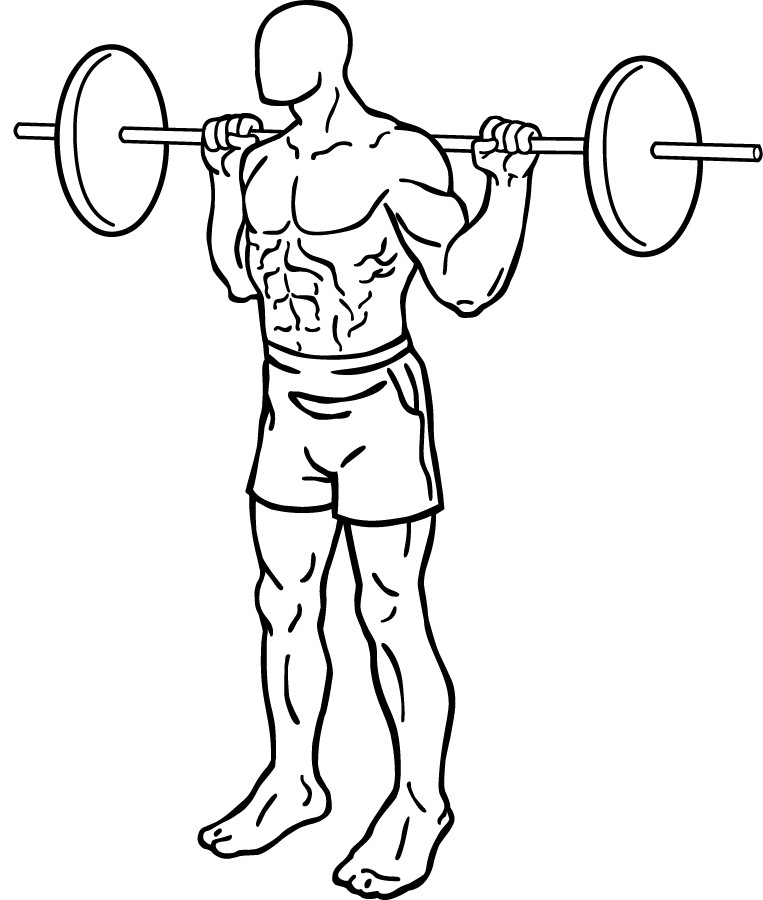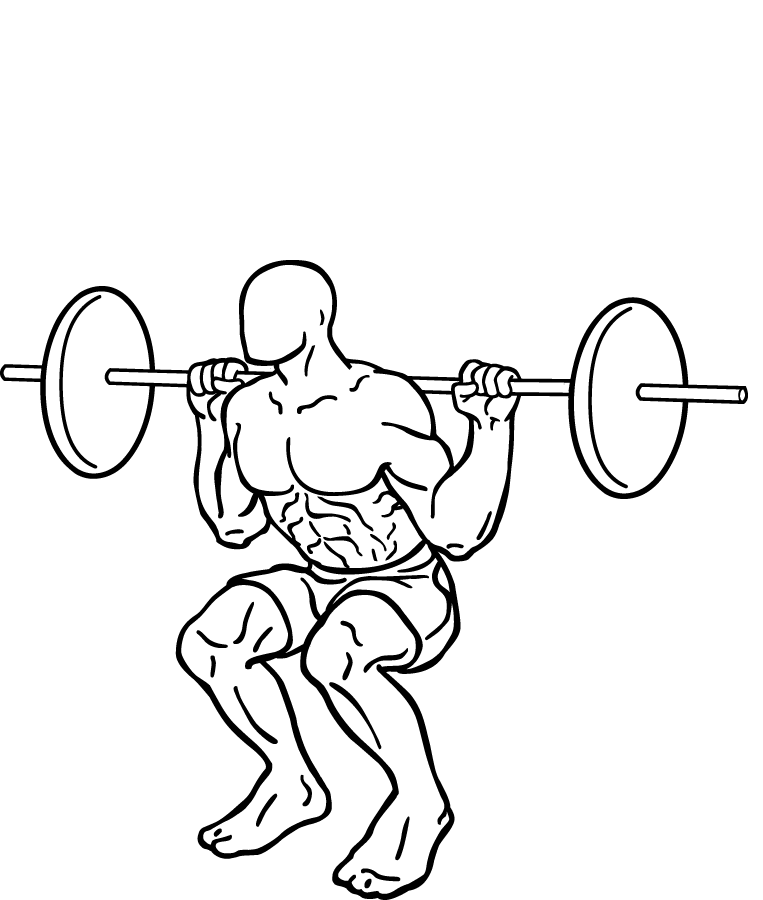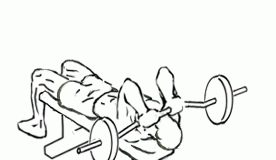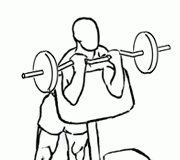Last Updated on November 2, 2024
The Narrow Stance Squat with Barbell is an exceptional exercise that targets the entire lower body, with an emphasis on the outer leg muscles, particularly the outer quadriceps and glutes. By positioning your feet closer together, you create a more focused engagement on these muscles, adding definition and strength to the legs and creating a well-balanced lower body physique. This squat variation is suitable for lifters at all levels, whether you’re aiming to build leg strength, improve muscle definition, or simply add variety to your leg day routine.
In this guide, we’ll dive into the benefits of the narrow stance squat, provide detailed step-by-step instructions, discuss common mistakes, offer tips, and explore variations. By the end, you’ll have all the knowledge you need to incorporate this powerful exercise into your workout routine and build stronger, more defined legs.
Why the Narrow Stance Squat with Barbell is Effective
Adjusting your squat stance to a narrower position shifts the emphasis to the outer quads, giving this exercise a unique advantage. Here’s why it’s effective:
- Targets Outer Quadriceps and Glutes: The narrow stance shifts the focus toward the outer quads, which helps create a balanced, defined look in the thighs and improves overall leg aesthetics.
- Enhances Core and Lower Body Strength: Squats are a compound movement, meaning they work multiple muscle groups simultaneously. The narrow stance squat engages the core and lower back to stabilize the movement, building a stronger lower body and core.
- Improves Mobility and Balance: With a narrower stance, you’re forced to stabilize through your core and lower body, improving balance, control, and flexibility over time.
- Prepares You for Other Compound Movements: Mastering this squat variation helps build foundational strength and body awareness, which can enhance performance in other lifts like deadlifts and lunges.
Muscles Targeted in the Narrow Stance Squat with Barbell
This squat variation primarily targets:
- Quadriceps (Outer Quads): The narrow stance places emphasis on the outer quads (vastus lateralis), giving the thighs a more sculpted and balanced appearance.
- Glutes: The glutes are heavily engaged to support the downward and upward motion, helping build strength and shape.
- Hamstrings: The hamstrings assist in controlling the movement, adding stability and support during both the descent and ascent.
- Core Muscles: Your core must remain engaged throughout the movement to stabilize the torso and maintain balance.
Step-by-Step Guide to Performing the Narrow Stance Squat with Barbell
Step 1: Set Up the Barbell
- Approach the Rack: Position yourself under a barbell in a squat rack. The bar should be set at about shoulder height.
- Position the Bar on Your Shoulders: Step under the barbell, allowing it to rest on your upper back and traps. Avoid placing it directly on your neck; it should rest comfortably just below.
- Grip the Bar Firmly: Grasp the bar with your hands slightly wider than shoulder-width. Your elbows should be slightly tucked in to stabilize the bar on your back.
Step 2: Position Your Feet
- Step Out from the Rack: Carefully lift the barbell by straightening your legs, then take a few steps back to create enough space for the squat.
- Place Your Feet in a Narrow Stance: Position your feet about 6 inches apart (roughly hip-width), with your toes slightly pointed outward. This alignment will target the outer quads and help maintain stability throughout the movement.
Step 3: Engage Your Core and Begin the Descent
- Engage Your Core Muscles: Draw your abs in and keep your chest up, engaging your core to support your lower back and prevent your torso from leaning forward.
- Lower Yourself Slowly: Begin descending by bending at the knees and hips, as if sitting down on a chair. Keep your knees aligned with your toes to avoid inward or outward drifting, which can strain the knees.
- Focus on Your Heels: Lower yourself as far as you can while keeping your heels planted firmly on the ground. Avoid shifting forward onto your toes, as this can throw off your balance and lead to form issues.
Step 4: Hold and Return to Starting Position
- Pause at the Bottom: Once you reach a comfortable depth (about parallel to the floor or lower if flexibility allows), pause briefly to maximize muscle engagement. This pause will create greater tension in the quads and glutes.
- Press Back Up Through Your Heels: Push through your heels to stand back up, extending your knees and hips simultaneously. Keep the movement controlled and avoid locking out your knees at the top to maintain tension.
- Maintain Upright Posture: Keep your chest lifted and core engaged as you return to the starting position.
Repeat for the desired number of reps, focusing on maintaining proper alignment and control.
Tips for Perfecting Your Form
Form is essential in squats, especially with the narrow stance variation. Here are some tips to help you perform the exercise safely and effectively:
- Keep Your Core Tight: A strong, engaged core provides stability and prevents your torso from leaning forward. This is crucial for maintaining balance and protecting your lower back.
- Avoid Locking Your Knees: At the top of each rep, keep a slight bend in your knees instead of locking them out. This keeps tension in the muscles and prevents undue stress on the knee joints.
- Focus on Depth, Not Speed: Slow and controlled movements are more effective than quick reps. Aim to reach parallel or slightly below to maximize muscle engagement and flexibility.
- Maintain Upright Posture: Keep your chest lifted and shoulders back to prevent rounding in the upper back, which can lead to poor form and reduced effectiveness.
Common Mistakes and How to Avoid Them
To get the most out of the narrow stance squat, avoid these common mistakes:
- Rounding the Lower Back: Keep your back straight and chest lifted. Rounding the lower back can strain the spine, especially with added weight. Engaging the core can help maintain proper posture.
- Allowing Knees to Cave Inward: When descending, keep your knees aligned with your toes. Knees caving inward (valgus collapse) can increase the risk of knee injuries. Focus on tracking your knees over your toes.
- Using Excessive Weight: It’s tempting to lift heavy, but form should always come first. Start with a manageable weight and increase gradually as your strength and form improve.
- Shifting Weight Onto the Toes: Pressing through the toes can cause instability and reduce muscle activation in the quads and glutes. Focus on pressing through your heels to maintain stability.
Variations of the Narrow Stance Squat with Barbell
Adding variation to your squat routine can help target different areas of the lower body and prevent plateaus. Here are some effective narrow stance squat variations:
1. Narrow Stance Goblet Squat
Hold a dumbbell or kettlebell close to your chest and perform the squat with a narrow stance. This variation reduces the load on your back and emphasizes the quads and glutes while providing additional core engagement.
2. Front Squat with Narrow Stance
Place the barbell across the front of your shoulders instead of on your back. The front squat increases core demand and allows for a more upright posture, which is particularly effective for targeting the quads.
3. Narrow Stance Smith Machine Squat
Using a Smith machine allows for a more controlled movement path, making it easier to focus on depth and form. This variation is ideal for beginners or those recovering from an injury, as it reduces balance requirements.
4. Single-Leg Narrow Stance Squat (Bulgarian Split Squat)
Using one leg at a time in a narrow stance, place your rear foot on a bench behind you. This variation challenges your balance and isolates each leg individually, improving muscle imbalances.
5. Narrow Stance Sumo Squat
Position your feet closer together while holding a dumbbell or kettlebell between your legs. This squat variation focuses on the inner thighs and glutes while providing additional quad engagement.
Sample Lower Body Workout Incorporating the Narrow Stance Squat
Here’s a balanced lower body workout that includes the Narrow Stance Barbell Squat as a key movement:
- Warm-Up: 5-10 minutes of light cardio and dynamic stretching for the legs and hips.
- Narrow Stance Barbell Squat: 4 sets of 8-10 reps, focusing on form and outer quad engagement.
- Lunges (Dumbbell or Barbell): 3 sets of 12 reps per leg to target the quads, glutes, and hamstrings.
- Leg Press with Narrow Stance: 3 sets of 10-12 reps to complement the squat and further target the outer quads.
- Romanian Deadlift: 3 sets of 10 reps to focus on hamstrings and glutes.
- Calf Raises (Standing or Seated): 4 sets of 15-20 reps to develop calf strength and balance the lower leg muscles.
- Cool Down: Light stretching for the quads, hamstrings, glutes, and calves.
Safety Tips for the Narrow Stance Squat
Since squats involve complex movement patterns and weight on your back, it’s essential to keep safety in mind:
- Use Proper Weight: Start with a lighter weight to ensure you can maintain form. As you become comfortable with the movement, gradually increase the weight, but always prioritize technique over load.
- Engage Your Core: Keeping your core engaged helps stabilize your spine, preventing excessive forward lean or rounding in the lower back, which can lead to injury.
- Maintain Full Foot Contact: Ensure your entire foot remains in contact with the ground throughout the movement. Pressing through your heels rather than your toes improves stability and reduces strain on the knees.
- Consider a Spotter or Safety Rack: If you’re lifting heavy, using a spotter or setting the safety pins in a squat rack at an appropriate height can prevent injuries if you can’t complete a rep.
- Warm-Up Thoroughly: Squats demand flexibility in the hips, knees, and ankles. Prioritize warming up with dynamic stretches and lighter sets to prepare your muscles and joints for the exercise.
- Rest and Recover: Squats are taxing on the body, particularly with a narrow stance that requires balance and focus. Allow sufficient recovery time between squat sessions to avoid overuse injuries and muscle fatigue.
Progressive Overload Techniques
Progressive overload is essential to maximize strength and muscle gains with the narrow stance squat. Here’s how to apply it:
- Gradually Increase Weight: Start with a weight you can manage with good form, then add small increments as you become stronger. Aim to increase the weight every few weeks if your form remains solid.
- Add Repetitions: If you’re using a manageable weight, work on increasing your reps. For instance, if you’re performing 8 reps per set, work toward 10 or 12 reps before increasing the load.
- Add a Pause at the Bottom: Holding a 1-2 second pause at the bottom of each squat intensifies muscle engagement. This pause increases time under tension, building endurance and strength.
- Increase Sets: Add an extra set to your squat routine if you find that your muscles are adapting to the workload. Adding volume can help break through plateaus and promote muscle growth.
- Tempo Variations: Slowing down the eccentric (lowering) phase to 3-5 seconds increases time under tension and challenges your muscles, particularly the quads and glutes.
Integrating the Narrow Stance Squat into Different Workouts
The Narrow Stance Squat with Barbell is versatile and can be incorporated into various workout routines:
- Leg Day: Use it as a primary or secondary exercise for targeting the outer quads, followed by lunges, deadlifts, or leg presses.
- Lower Body Strength Training: Pair it with other compound movements like Romanian deadlifts and calf raises for a complete lower-body workout.
- Full-Body Routine: Use it as one of your primary lower-body exercises on full-body workout days, especially if you’re focusing on quad and glute development.
- Hypertrophy (Muscle Growth) Focused Workouts: For those aiming to build muscle, incorporate higher reps (10-15) with moderate weight to enhance muscle size and definition.
Tracking Your Progress
Recording your progress over time helps you stay motivated and see improvements. Here are some ways to track your performance:
- Weight Lifted: Track the weight you’re lifting each week and gradually aim to increase it as your strength improves.
- Reps and Sets: Record the number of reps and sets completed. Increasing reps or sets over time indicates progress.
- Depth and Range of Motion: Monitor your squat depth and comfort at lower ranges of motion. Improved depth can reflect gains in flexibility and muscle strength.
- Form and Control: Take notes on any form adjustments or improvements, such as better core engagement or reduced knee cave-in. Good form leads to better, safer results.
Frequently Asked Questions (FAQs)
1. How does the narrow stance squat differ from a regular squat?
- The narrow stance squat places your feet closer together, which shifts more emphasis to the outer quads and challenges balance. It targets the legs differently than a regular squat, which engages the entire thigh area more evenly.
2. Is the narrow stance squat safe for beginners?
- Yes, beginners can perform the narrow stance squat, but they should start with a light weight (or bodyweight) to master form and balance before adding load.
3. Should I go below parallel in the narrow stance squat?
- Going below parallel (when the thighs are lower than the knees) can enhance muscle activation, but only if your flexibility and mobility allow it. Avoid going too low if it causes discomfort or poor form; focus on a controlled range that works best for you.
4. Can I perform narrow stance squats without a barbell?
- Absolutely. You can perform the narrow stance squat with bodyweight, dumbbells, or a kettlebell. These options allow you to practice form, balance, and range of motion before progressing to a barbell.
5. How often should I do the narrow stance squat?
- Including it once or twice a week as part of a lower-body workout is usually sufficient. It’s important to give your muscles time to recover between intense sessions.
Final Thoughts
The Narrow Stance Squat with Barbell is a powerful exercise for anyone looking to improve leg strength, shape, and definition, with a special emphasis on the outer quads. By narrowing your stance, you can challenge your muscles in a new way, promoting balanced lower-body development and enhancing the aesthetics of your legs.
When executed with proper form and applied progressive overload, this squat variation can become a staple in your lower-body routine, helping you build a strong, functional, and visually balanced physique. Remember to prioritize form over weight, track your progress, and integrate it into a well-rounded leg day or lower-body workout. With consistency, focus, and dedication, the Narrow Stance Squat with Barbell can help you reach your fitness goals and build powerful, defined legs.








